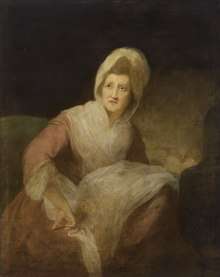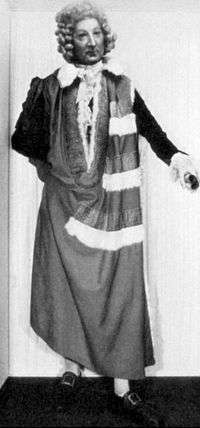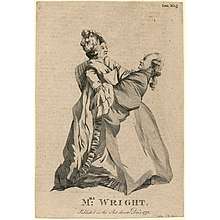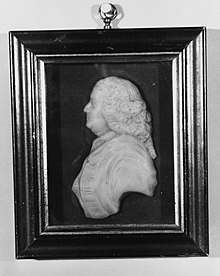Patience Wright
Patience Lovell Wright (1725 – March 23, 1786) was a sculptor of wax figures, and the first recognized American-born sculptor.[1]
Patience Wright | |
|---|---|
 Portrait of Patience Wright | |
| Born | Patience Lovell 1725 |
| Died | March 23, 1786 London, England |
| Known for | Sculpture |
Notable work | lifesize wax sculptures |
Biography
Early life
Patience Lovell was born at Oyster Bay, New York, into a Quaker farm family with a vegetarian diet. The family moved to Bordentown, New Jersey when Patience was four years old.[2] At age 16 she left the family home and moved to Philadelphia, where in 1748 she married Joseph Wright, a barrelmaker who was many years her senior. She often amused herself and her children by molding faces out of putty, bread dough, and wax.
Occupation
When Wright's husband died in 1769, she was pregnant with a fourth child and needed a way to support the family. Working with her sister Rachel Wells, who by then was also a widow, she turned her hobby into a full-time occupation.[3] The sisters set up a business molding portraits in tinted wax, a popular art form in colonial America, and charged admission to see them.[4] By 1770 they had become successful enough to open a waxworks house in New York City and mount tours of their work to Philadelphia and Charleston.[1] Contemporary physician Solomon Drowne mentions a visit to the waxworks in his journals.[3]
Wright's portraits were life-sized figures or busts with real clothing and glass eyes. They were modeled from life and were considered to be very lifelike.[4] They were often placed in tableaux, illustrating the activities the portrayed individual might have undertaken in life.[1]
After many of her sculptures were destroyed in a fire in June 1771, Wright relocated to London, England.[1][3] Through a relationship with Jane Mecom, sister of Benjamin Franklin, she made her entry into London society.[2] Wright settled in the West End and set up a popular waxworks show of historical tableaux and celebrity wax figures. She was honored with an invitation to model King George III, and would go on to sculpt other members of British royalty and nobility.[1] Although Wright is recorded as creating at least fifty-five works, only her full-length figure of Lord Chatham (William Pitt) is extant.[5]

Public reputation
Patience Wright became known in London society for her rustic American manners, which were a source of both fascination and scandal. She wore wooden shoes, kissed members of both sexes and all classes in greeting, and in general did not follow the contemporary rules of comportment for someone of her class or gender.[2] One rumor held that she had even called the king and queen by their first names, in an outrageous breach of conduct.[1] Her reputation for unruliness led to the nickname "The Promethean Modeler", and she gained a level of celebrity in 18th-century London.[2] Wright famously offended Abigail Adams with her overfamiliarity and lack of modesty about her skills. Adams wrote a disparaging letter home describing their encounter, describing her as "the queen of sluts."[1]
Wright's technique for sculpting wax contributed to this public conception of her character. She used body heat to keep the wax at a temperature where she could shape it, molding it under her apron in a suggestive manner, which scandalized viewers and was even parodied in newspaper cartoons.[6] The medium itself was a form of "low art" and considered unrefined when compared to sculpture in bronze or stone.[7]

Wright may have used this unconventional public persona as a way to drive business to her waxworks, making savvy use of newspaper coverage to get publicity for her artwork.[1]
Revolutionary War activities
Wright is said to have worked as a spy during the American Revolution, sending information back to the colonies inside her wax figures.[2] The accuracy of this legend has been contested.[8][4] She is known to have corresponded with Benjamin Franklin during the war, sending letters reporting on the health of his illegitimate son, William, and advocating on behalf of prisoners of war.[9][10][11] She also wrote letters to John Dickinson describing the British Army's preparations in England.[4]
Wright eventually fell from royal favor as a result of her open support for the colonial cause, especially after she reportedly scolded the king and queen after the battles of Lexington and Concord.[2] She was an outspoken patriot, and started a fund to support American prisoners of war held in Britain.[11] A group of pro-American activists, including Lord George Gordon, Benjamin West, and Anthony Pasquin, would meet at her London workshop to discuss their cause.[12][13]
Wright moved to Paris in 1780, where she modeled a portrait of Benjamin Franklin.[1]
Postwar and death
Wright returned to England in 1782 and settled with her daughter Phoebe and her son-in-law, painter John Hoppner at their home on Charles Street at St. James's Square.[1][14] By 1785 she had decided to return to New Jersey. However, as she was making preparations to travel, she suffered a bad fall and broke her leg. Patience Wright died a week later, on March 23, 1786. Her sister Rachel attempted to get financial assistance for her burial expenses, both from prominent American citizens and then from the Continental Congress, but was not successful. Wright was buried in London. Her burial place is unknown.[2]
Although Wright had obtained George Washington's agreement to sit for a portrait with her, she died before she could sculpt him.[1] A similar request sent to Thomas Jefferson would go unanswered.[2]
Selected works
The fragility of her medium means that few of Wright's works survive today.[4] A full-length figure of William Pitt, produced after the Earl’s death, still stands in Westminster Abbey Museum.[15] A bas-relief profile of Admiral Richard Howe in the collection of the Newark Museum is attributed to her.[1]
Wright's also made sculptures of Prime Minister William Pitt, Lord Lyttelton, Thomas Penn, and Charles James Fox. Wright's patrons included Benjamin Franklin, Deborah Sampson, the King and Queen of England, and William Pitt.[1]

Legacy
Patience Wright's son Joseph Wright (1756–1793) was a well-known portrait painter who designed Liberty Cap Cent. Her daughter Phoebe married British painter John Hoppner; their son, Henry Parkyns Hoppner, went on to become a Royal Navy officer and Arctic explorer.
Her home at 100 Farnsworth Avenue in Bordentown, New Jersey still stands.[16][17]
In literature
Wright was featured as a character in Lillian de la Torre's story "The Frantick Rebel," part of her series featuring Samuel Johnson as a detective, with Wright successfully tricking Johnson into supplying information to an American spy.
References
- Rubinstein, Charlotte Streifer (1982). American Women Artists. Boston, MA: G.K. Hall & Co. p. 23.
- The Madame Tussaud of the American Colonies Was A Founding Fathers Stalker, Smithsonian.com Weekly Newsletter (29 December 2013)
- GOODFRIEND, JOYCE D. (2001). "New York City in 1772: The Journal of Solomon Drowne, Junior". New York History. 82 (1): 25–52. JSTOR 42677751.
- Bullion, J. L. (1978). "Review of Patience Wright: American Artist and Spy in George III's London". The William and Mary Quarterly. 35 (3): 584–586. doi:10.2307/1921677. JSTOR 1921677.
- Kathleen, Dabbs, Julia (2009). Life stories of women artists, 1550-1800 : an anthology. Farnham, England. p. 422. ISBN 9780754654315. OCLC 317824669.
- Walsh, Megan (2012). "Review of Shaping the Body Politic: Art and Political Formation in Early America". Journal of the Early Republic. 32 (3): 512–515. doi:10.1353/jer.2012.0051. JSTOR 23315169.
- Bjelajac, David (2002). "Confessions of a Survey Writer". American Art. 16 (2): 7–10. doi:10.1086/444662. JSTOR 3109380.
- "Patience Wright | American artist". Encyclopedia Britannica. Retrieved 2017-10-19.
- Sletcher, Michael (2006). "Domesticity: The Human Side of Benjamin Franklin". OAH Magazine of History. 20 (2): 47–52. JSTOR 25162034.
- Baetjer, Katharine (2003). "Benjamin Franklin's Daughter". Metropolitan Museum Journal. 38: 169–11. doi:10.2307/1513106. JSTOR 1513106.
- Davis, Robert S. (2000). "A Georgian and a New Country: Ebenezer Platt's Imprisonment in Newgate for Treason in "The Year of the Hangman," 1777". The Georgia Historical Quarterly. 84 (1): 106–115. JSTOR 40584229.
- McCalman, Iain (1996). "Mad Lord George and Madame La Motte: Riot and Sexuality in the Genesis of Burke's Reflections on the Revolution in France". Journal of British Studies. 35 (3): 343–367. doi:10.1086/386111. JSTOR 175918.
- Palumbo, Anne Cannon (1995). "Averting "Present CommotionsPenn's Treaty"". American Art. 9 (3): 29–55. doi:10.1086/424251. JSTOR 3109206.
- Baetjer, Katharine (1999). "British Portraits: In the Metropolitan Museum of Art". The Metropolitan Museum of Art Bulletin. 57 (1): 1–72. doi:10.2307/3258857. JSTOR 3258857.
- "New Collaboration to Reveal Secrets of Nelson and Pitt Effigies". Westminster Abbey. May 2017. Retrieved 3 May 2017.
- Downtown Bordentown Association Archived 2007-12-10 at the Wayback Machine
- Patience Lovell Wright House Historical Marker
External links
- Union List of Artist Names, Getty Vocabularies. ULAN Full Record Display for Patience Lovell Wright. Getty Vocabulary Program, Getty Research Institute. Los Angeles, California.
- https://web.archive.org/web/20110727195150/http://www.rabungap.org/uploaded/faculty/twass/American_History/Historical_Figures_for_Colonial_Town_Meeting.htm
- https://web.archive.org/web/20100729023307/http://www.npg.si.edu/col/age/wright.htm
- http://score.rims.k12.ca.us/score_lessons/women_american_revolution/wright.html
- Burstyn, Joan N. Past and Promise: Lives of New Jersey Women (Syracuse University Press, 1997)
- Kerber, Linda K. Toward an Intellectual History of Women: Essays (Univ. of North Carolina Press, 1997)
- Lepore, Jill. Book of Ages: The Life and Opinions of Jane Franklin (Knopf, 2014)
- Mays, Dorothy. Women In Early America: Struggle, Survival, and Freedom in a New World (ABC-CLIO, 2004)
- Sellers, Charles Coleman. Patience Wright: American Artist and Spy in George III's London (Wesleyan University Press, 1976)
- To George Washington from Patience Lovell Wright (8 December 1783), Founders Online, National Archives
- To Thomas Jefferson from Patience Wright (14 August 1785), Founders Online, National Archives
- The Papers of Benjamin Franklin, The American Philosophical Society and Yale University